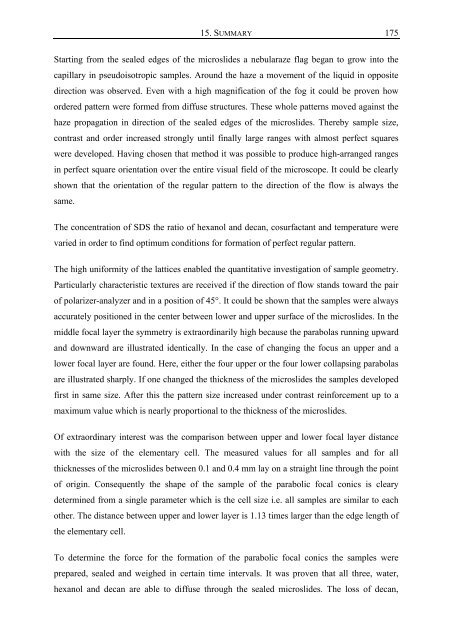Dokument_1.pdf (24284 KB) - OPUS Bayreuth - Universität Bayreuth
Dokument_1.pdf (24284 KB) - OPUS Bayreuth - Universität Bayreuth
Dokument_1.pdf (24284 KB) - OPUS Bayreuth - Universität Bayreuth
Sie wollen auch ein ePaper? Erhöhen Sie die Reichweite Ihrer Titel.
YUMPU macht aus Druck-PDFs automatisch weboptimierte ePaper, die Google liebt.
15. SUMMARY 175<br />
Starting from the sealed edges of the microslides a nebularaze flag began to grow into the<br />
capillary in pseudoisotropic samples. Around the haze a movement of the liquid in opposite<br />
direction was observed. Even with a high magnification of the fog it could be proven how<br />
ordered pattern were formed from diffuse structures. These whole patterns moved against the<br />
haze propagation in direction of the sealed edges of the microslides. Thereby sample size,<br />
contrast and order increased strongly until finally large ranges with almost perfect squares<br />
were developed. Having chosen that method it was possible to produce high-arranged ranges<br />
in perfect square orientation over the entire visual field of the microscope. It could be clearly<br />
shown that the orientation of the regular pattern to the direction of the flow is always the<br />
same.<br />
The concentration of SDS the ratio of hexanol and decan, cosurfactant and temperature were<br />
varied in order to find optimum conditions for formation of perfect regular pattern.<br />
The high uniformity of the lattices enabled the quantitative investigation of sample geometry.<br />
Particularly characteristic textures are received if the direction of flow stands toward the pair<br />
of polarizer-analyzer and in a position of 45°. It could be shown that the samples were always<br />
accurately positioned in the center between lower and upper surface of the microslides. In the<br />
middle focal layer the symmetry is extraordinarily high because the parabolas running upward<br />
and downward are illustrated identically. In the case of changing the focus an upper and a<br />
lower focal layer are found. Here, either the four upper or the four lower collapsing parabolas<br />
are illustrated sharply. If one changed the thickness of the microslides the samples developed<br />
first in same size. After this the pattern size increased under contrast reinforcement up to a<br />
maximum value which is nearly proportional to the thickness of the microslides.<br />
Of extraordinary interest was the comparison between upper and lower focal layer distance<br />
with the size of the elementary cell. The measured values for all samples and for all<br />
thicknesses of the microslides between 0.1 and 0.4 mm lay on a straight line through the point<br />
of origin. Consequently the shape of the sample of the parabolic focal conics is cleary<br />
determined from a single parameter which is the cell size i.e. all samples are similar to each<br />
other. The distance between upper and lower layer is 1.13 times larger than the edge length of<br />
the elementary cell.<br />
To determine the force for the formation of the parabolic focal conics the samples were<br />
prepared, sealed and weighed in certain time intervals. It was proven that all three, water,<br />
hexanol and decan are able to diffuse through the sealed microslides. The loss of decan,
















